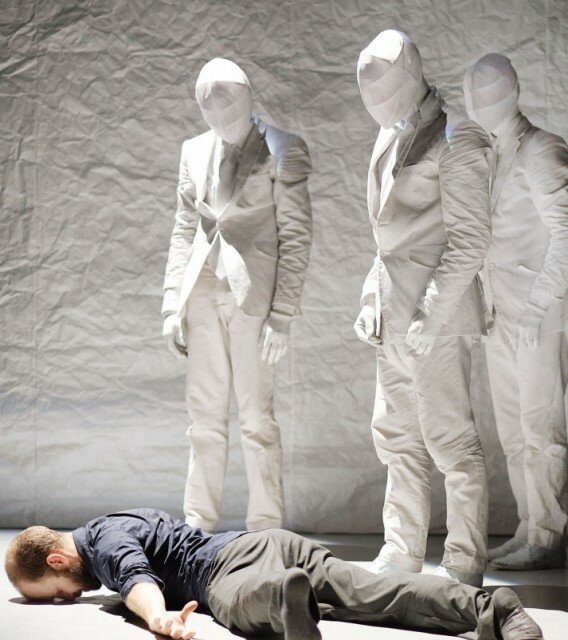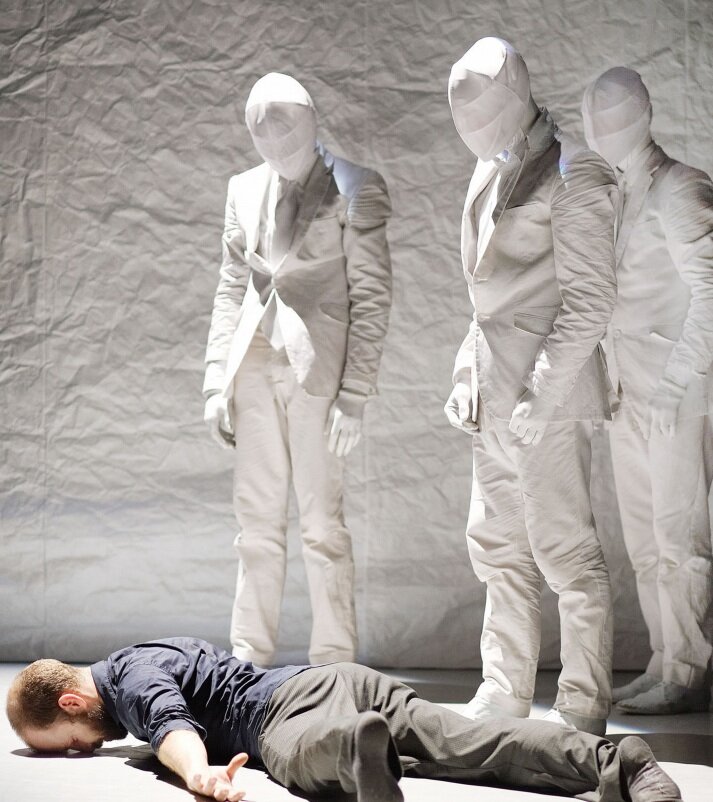
The Tempest is thought to be the last play to have been written in its entirety by Shakespeare. First performed five years before his death 396 years ago, it is a story that looks back on a life’s work seeking to right wrongs, establish a legacy, and forgive nemeses. Crystal Pite and her company, Kidd Pivot, present a haploid exploration of The Tempest in a sold-out run of The Tempest Replica at On The Boards (through October 25).
The dance company plays out the story, shatters it, and replays it. These correlated dance verses offer an artistic approach to questions more often left to scholars that effectively relates the story to the streets beyond the theatre.
I really identified with, as any director does, the character of Prospero, his conflict between trying to reconcile his ambition and his magic and his art with his family and his humanity. —Crystal Pite in conversation with Peter Boal
A synopsis of the plot and selected passages from the play are projected on a wall of On The Boards’s lobby before the house opens. They note that the central character and deposed Duke, Prospero, has learned magical arts and employs them and the enslaved natives of his adopted home to spin a scheme that reeks vengeance on his usurpers and expands his estate by marrying his daughter to a rival ruler’s son.
Prominent themes touch on the nature of art, the consequences of colonialism, and notions of justice. These qualities, along with the spectacular elements, have made The Tempest popular grist for artistic adaptation in all media. The key role of visions and illusion have made it especially popular in film (Taymor, Greenaway, Wilcox, et al.) so it is appropriate that projections are prominent in The Tempest Replica.
The first half of the performance tells the story of The Tempest with Prospero in dark clothes creating the story. He brings to life neutral masked dancers encased in matte white like a collection of puppets. With Prospero’s careful attention the characters develop from inanimate sculptures to nearly life-like automata that retain just enough stiffness to remind us that they aren’t quite real.
I think there’s something about an anonymous body that excites me, just because I think when you are a viewer, you are always drawn to watch the face of a performer—which is really beautiful and compelling and interesting, and I love watching faces just as much as the next person but, if you take the face away, you’re able to really watch the body. —Crystal Pite in conversation with Peter Boal
In the second half key scenes are replayed in street clothes that reduce the relationships’ psychological distance, bringing the story more into our own lives. Meanwhile the dance takes flight with larger, more acrobatic and vigorous movement. The psychology of the piece grows more nuanced, further reducing the distance while retaining the emotional extremes. This also provides opportunities for solos among the dancers. The solos plumb the depths of Ferdinand’s fear, Caliban’s rage at his enslavement, Antonio’s similar but less justified rapacity, and Miranda’s heartrending empathy.
The dance is finely executed with a broad vocabulary and acts of stunning agility that are delivered with extraordinary understatement. The audience learns the vocabulary as Prospero teaches it to the minions of the story, which aids in communicating the more fluid and extrapolated storytelling of the second half.
Those interested in production approaches to The Tempest would do well to examine The Tempest Replica and the clever ways Pite and company approach the dramaturgical challenges using the bare minimum of language. In fact language enters frequently with projections of words that come as shocks of the intellectual. Scrims do much of the work as projection surfaces but there are wonderful moments of surprise in which a skirt of a crumpled sheet of paper is smoothed allowing words to appear.
There are also inspired moments of physical storytelling as with the long, Nosferatu-fingers of the chief villain, Antonio. These both set him apart from his pawn, Sebastian, and convey his royal ambitions as fingers become a crown.
Shadows facilitate doubling as characters view themselves in live or recorded shadow projections. A shadow decapitation undercuts its own horror by its delightful execution. Shadow puppetry also makes light work of the cumbersome but vital exposition scene of the opening act. The backstory is played here in shadow-puppet styled video that transfers well to the monochromatic rendering of the dancers.
Kidd Pivot takes a few liberties with the text, removing the sympathetic courtier Gonzalo as well as the clowns Trinculo and Stephano. Ferdinand’s logs, often used to euphemistic effect in productions of the play, are exchanged for a Sisyphean stone. These cuts diminish the colonial and theological aspects of the story, but with so many avenues open to interpretation selection is key to success. The Tempest Replica unquestionably succeeds in creating a valuable addition to the body of artistic interpretations of The Tempest.
